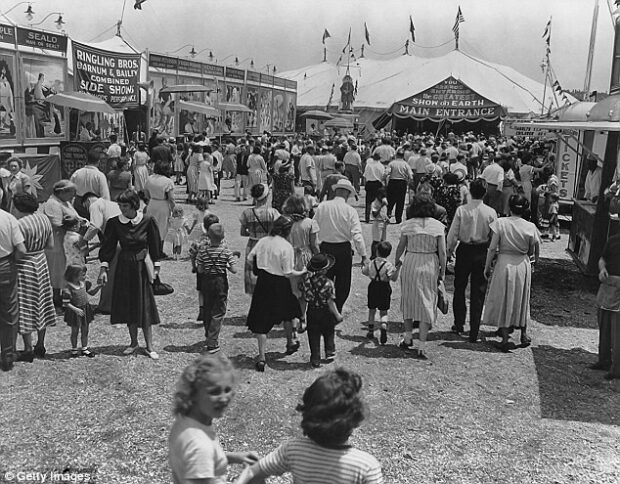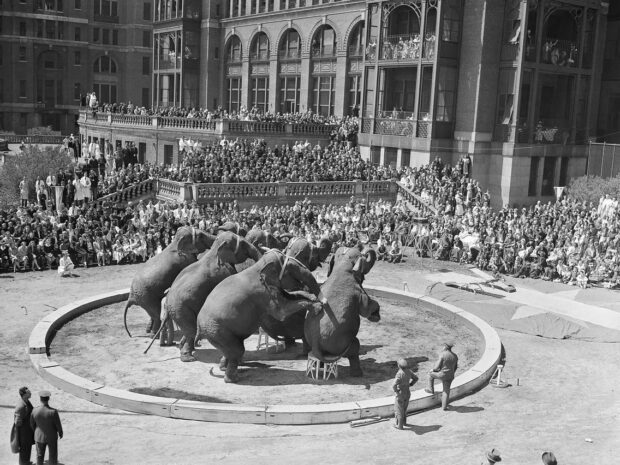
The American circus was different from its European brethren. Its creators sought not just to show the audience an acrobatic set, but to full-fledged action with bright flags, loud music. Even the volume of such action was enormous. It left a strong imprint on a future circus in the states, and yet only the equestrian numbers could not exist apart from the carousels, music, sales of cotton candy. They say, «distance changes everything» – it’s about circuses on both sides of the Atlantic Ocean.
The first traces of the circus we find in cave drawings of Aztecs: they juggle feet and hands, stand on the head, one hand. In the capital of the ancient people, Montezuma, there were frequent battles of gladiators, judging by the drawings. Isn’t this the current Plaza del Toros Mexico City stadium? – But in the early 18th century, they show the first trained lion in the states, and then surprise the audience with a polar bear that has never been seen before. And already in the 80s, American Poole presents a unique on his successful equestrian clown «Billy Byton or the trip of the tailor to Branford». The audience was thrilled!
The first circus, still wooden, appears in Philadelphia in 1893. It is opened by John Ricketts, one of Charles Hughes’ artists. There are horse-and-acrobatic numbers on the stage, dancing on a suspended rope, funny. Not surprisingly, the same circus soon appears in New York City and Ricketts changes the intersection of 12th Avenue and Market Street to downtown.
READ 10 iconic NYC Instagram spots (and how to get the best shot)
Interestingly, his circus even looked like him. A round room, a dome instead of a roof, at the top, is a horseman standing on a horse. The only problem is that even the most beautiful tree burns easily. That’s what happened in 1799. Mephistopheles himself came on the stage, surrounded by fire, in the pantomime «Juan in Hell». But the flames not only spread foul but also spread to wooden scaffolding, walls.
The spectators had difficulty escaping, but the circus did not survive. A little later Ricketts’ second child, in New York, burns up. And John Bill Ricketts himself crashes into the sea on his way home. But his rooms were in the hearts of the audience. A special admirer was George Washington, who often took horseback riding lessons from a circus artist.
Victor Papen and James West were the next people to win over in America. On Broadway, they showed the same equestrian acrobatics, the same adventures of a tailor who can’t hold his horse. But it wasn’t a regular program. The first stationary circus is Stanford. It opens in 1826.
But two, however large, stationary circus circuses could not fully meet the needs of the audience. And in America, mobile capital appeared. Ridgebury Turner and Nathan Hawes, one of whom had previously repaired shoes and the other had shown trained animals, in 1830 built a rag-rag with a tarpaulin roof. He’s the one they’re traveling with.
They show, as usual, the wonders of horseback riding. Later they are joined by a juggler. The performances are very popular with the audience. And all would be well, just from across the ocean in 1836, Thomas Cook, who is also interested in making fame and money. In retaliation for the British, but much later, Nathan’s brother, Seth, sails for England. He is the first to come up with a spectacular circus advertisement: instead of the invisible ragged leaflets that were pasted in pubs, his posters are covered in gold and hung on each post.
READ Just Teresa: Became a Millionaire Twice and Set a Record?
Other circuses did not fall behind. If the troupe flourished, it traveled on gold-plated carts, had a chic stable, outfits. However, bad weather could have spoiled everything, and overnight the spectacular circus turned into dirty and thin rags. Fighting was not uncommon: blood was raging, sometimes one word was enough for the circus to jump into battle.
Soon the first circus syndicate was formed in New York. June, Crane, Angevin, Titus were people with money, together they bought the Zoological Institute and all the animals, and then they started showing them.
Americans are very fond of elephants and the more «herd of trunks» were available in the circus – the more successful they were. But simple animal displays quickly bore the audience. Then entrepreneurs quickly invite the famous tamer Isaac van Amburg. In his enclosure, a lion and a lamb lived together, a child played with predators, and an elephant threw obediently on the back of a tamer. And the rhino became the only living animal out of myth: the unicorn. The North Salem Syndicate, as they call themselves in the circus alliance, and that seems small.
They buy a mobile circus, then another and another. And soon most of the circus chapiteau in the country will be their property. Undoubtedly, there was a good calculation: each circus worked only in its own state, they did not compete with each other, so they provided a good profit. As a result, even famous rich people began to invest their money in this profitable cause. The Circus of America was almost monopolized; it was until 1880.

A charismatic personality, John Robinson, was born in 1802. As a true adventurer, he traveled all over America with his circus, especially focusing on the South.
His athletic figure and his love of thrills allowed him to gain audience sympathy. And the circus at the time, he had a great one: 42 horses, a gold-plated van, a big troupe. As an old man, John continued to ride and perform. After his death, the circus did not break up, and under Robinson’s glory, he toured the cities. He later joined the Ringling Brothers.
No less well-known Spalding, nicknamed Doc (by profession – a pharmacist), contributed, however, not to art, but to construction. For greater stability, he added several sides supports to the chapiteau, allowing for several times space and more spectators. He then came up with horizontal supports that could be easily assembled and dismantled. They’re still in use. But the biggest construction is the floating circus. It was first launched into the Ohio River in 1852. It was called as «Floating Palace». Inside there was a long stage.
The room was decorated with red carpets, a chic chandelier, gilded. The palace held nearly 2,500 spectators. There were seats on both sides of the stage. The circus itself was at least four stories high. He was sailing on a flat barge pulled by a steamer.
Taking Rogers as their companion, they traveled from one town to another until their floating circus caught fire. The circus burned down completely in 1865.
But the companions also had a «backup plan» – circus-chapiteau. In parallel, they developed both directions: floating and railway. Сhapiteau became most famous because of a clown who worked there – Dan Rice. At one time he worked as a rider but later began to write funny scenes and songs, in each number he participated with his little piggy named Lord Byron.
READ Cameron Crews and Her Must Read Poetry Book “To The Monsters of My Past”
Everyone knew him, the whole country sang his lines. At the height of his popularity, he even tried to run for president instead of the deceased A. Lycoln. But he remained a beloved clown throughout America. His career began to develop towards sunset when Rice began to abuse alcohol. They didn’t want to deal with him, they rescinded the contracts, and in his old age, he became all abandoned and forgotten. But the lyrics of «Blow Off Roots or Die» knew every American. And yet the circus in America was different from the European. First of all, there was governance. These people clearly knew how to get the audience to put in more money, how to expand their influence, how to increase capital. This is how the Irish O’Brien, the Sells brothers, W. Cole came to the stage. But they were surpassed by Phineas Barnum.
In all the known adventures, you could hear his name. Fame for false Louis XV, Joyce Heth – his hand, and from mediocre artist Signor Vivalla he also made a famous juggler.
When before the «great inventor» becomes the question of what to do next, he buys the American museum of Scudder on Broadway. It used to be a showroom for wax panoptics and other rarities, but the old ones were quickly tired and the new ones were not brought in.
Impresario quickly finds a solution. In 1842, he filled the museum with live exhibits, dwarfs and giants, hairy people, albinos. At the center of the exhibition, he puts Niagara Falls in miniature and composes a legend of how he caught a siren with his own hands in Fiji.
In fact, it was nothing more than a trick: a hairy, dried monkey with fish fins and a tail. A few years later, his wealth allowed him to build a palace where he lived with his family. He constantly searched for new curiosities for his museum. Even though he had burned several times, he did not stop. So he opened a little boy with a thumb named Stratton, a beautiful Swedish singer named Lind, the cannibal people.
Together with the permanent museum, there was also a mobile version. He certainly impressed with his luxury, but even more breathtaking the «freaks» themselves and the way Barnum represented them. «The Great Asian Caravan, Barnum Museum, and Menagerie», as it was then called, reached the ears of Queen Victoria herself. Phineas had to perform in front of the royal family. And, I must say, he was excellent.
Like us on Facebook for more stories like this: